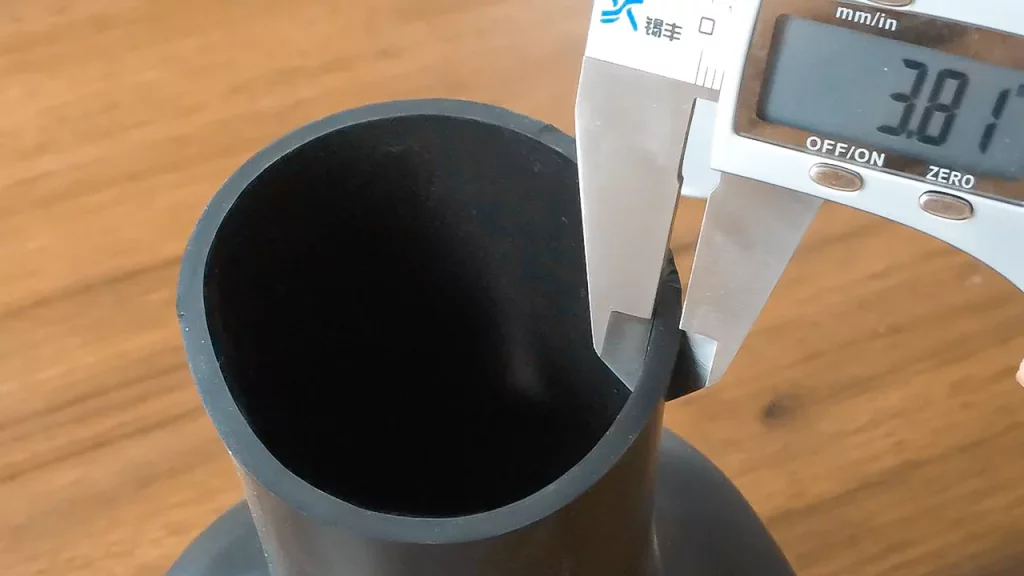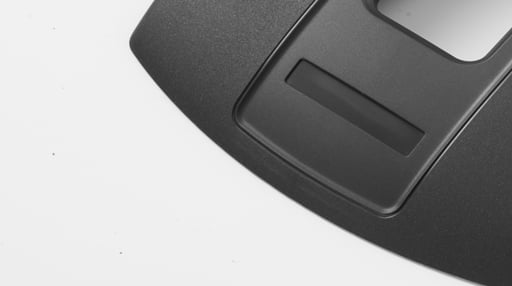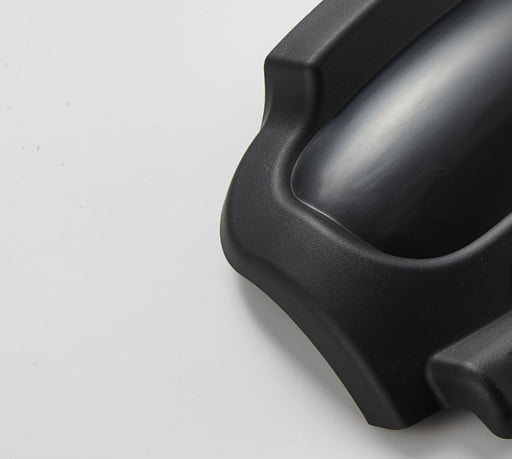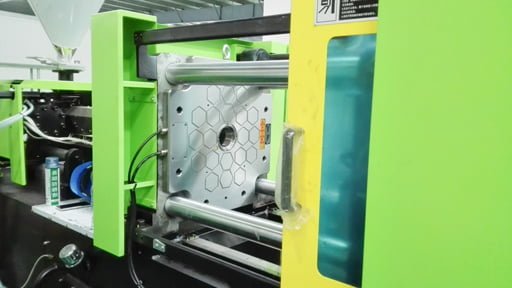The wall thickness of injection molded plastic products significantly impacts their quality. If the wall thickness is too thin, it will be challenging to meet the requirements for strength and rigidity and fill the cavity for large and complex products. Too thick will not only waste raw material but also quickly generate bubbles inside the plastic products, resulting in 欠陥 such as depressions in the product’s appearance. At the same time, it will extend the cooling time. As a result, from an economic standpoint, it is critical to thin a plastic product.

When constructing a plastic injection mold, examine if the plastic product’s thickness fits the molding process’s requirements. If the product is too thin, the flow resistance during injection is high, injection molding is complex, and the cavity cannot always be filled. And if the product is too thick, it wastes raw materials, lengthens the molding cycle, and quickly generates defects such as bubbles, dents, and warpage.
Let’s go over it in greater depth.
Wall Thicknesses Commonly Used in Plastic Products:
It is recommended that everyday plastic items have a wall thickness of 1-6mm, with a maximum of 8mm. The most typical wall thickness is 1.8-3mm, which varies according to the kind and size of the plastic element. In order to get to know wall thickness easily, the specifications of commonly used wall thicknesses under various plastic injection molding settings are shown in the table below.
Table: Recommended and minimum wall thicknesses for popular thermoplastic parts (mm)
| Plastic Material | Min. Thickness | Recommended Thickness of Small-sized Plastic Parts | Recommended Thickness of Mid-sized Plastic Parts | Recommended Thickness of Large-sized Plastic Parts |
| PA | 0.45 | 0.75 | 1.60 | 2.40~3.20 |
| PE | 0.60 | 1.25 | 1.60 | 2.40~3.20 |
| 追記 | 0.75 | 1.25 | 1.60 | 3.20~5.40 |
| PMMA | 0.80 | 1.50 | 2.20 | 4.00~6.50 |
| POM | 0.80 | 1.40 | 1.60 | 3.20~5.40 |
| PP | 0.85 | 1.45 | 1.75 | 2.40~3.20 |
| PC | 0.95 | 1.80 | 2.30 | 3.00~4.50 |
| PSF | 0.95 | 1.80 | 2.30 | 3,00~4.50 |
| UPVC | 1.15 | 1.60 | 1.80 | 3.20~5.80 |

Benefits of Ideal Wall Thickness in Plastic Products:
Walls thicker to provide additional strength are contrasted with thinner walls to provide certain other benefits. Maintaining a thinner and lighter part can obtain additional benefits when production runs longer. As a result, maintaining the optimal thickness is critical, especially when undertaking plastic injection molding projects with a high production volume. If you keep the wall as thin as possible, you will benefit from the following benefits:
• Greater resistance to warping during the cooling process
• Reduced overall weight makes handling, managing, packaging, and shipping easier.
• Less time spent cooling, allowing for faster and more efficient production
• Lower costs due to less material consumption and faster production
The wall thickness of a part is not constrained in any way. Still, the ultimate goal should be to create a wall as thin as possible while also considering structural requirements, overall dimensions, and geometry of a part. This would be accomplished while preserving the part’s integrity. Another essential factor to consider is the flow characteristics and qualities of the resin materials.

What Affects the Plastic Products Wall Thickness Design?
The requirements of an application determine the fundamental structure of a plastic product, which the manufacturer then determines. The choice of raw material influences the overall thickness of the product. As a result, when designing thick-walled plastic products under typical conditions, two elements, namely the conditions of application and the conditions of plastic production, should be considered. Structure, weight, strength, and insulating qualities are application circumstances; plastic manufacturing conditions include material fluidity, cooling time, ejection force, assembly strength, dimensional correctness, and other factors. For more information, please see the three points below:
· Structure Characteristics:
The plastic product’s basic structure primarily refers to its shape and size, determined by the criteria imposed on the product by its intended application. When a metal part is replaced with a plastic part or when a new plastic part is designed, you should change the structure and wall thickness of the metal part to conform to the plastic product’s wall thickness uniformity principle. This is because the shrinkage characteristics of plastic during injection molding differ from those of metal. The thick-walled component is recommended to be hollowed out and adjusted so that the wall thickness is consistent throughout.
After melting during the plastic injection molding process, plastics have a certain fluidity. This fluidity, however, varies greatly depending on the different types and grades of plastic. The following factors influence plastic fluidity: typically, the melt flow index (MFI) and the Archimedean spiral flow test are used to assess the fluidity of plastics. A higher melt flow index, in general, indicates greater fluidity. However, this is only sometimes the case.
As a result, the wall thickness of various materials-based products should be designed to be as fluidity-friendly as possible. It ensures adequate cavity filling, molten plastic’s flow speed is uniform in all directions, and the flow direction has the least resistance. Thinner walls can be designed for plastics with high fluidity, such as nylon, polyethylene, and polypropylene. The wall thickness can be increased for polymers with low fluidity, such as PC and PSF. This results in increased structural integrity.
· Factors Contributing to Products Strength:
The physical and mechanical properties of the raw material, when combined with specific structural requirements, determine the tensile strength of a plastic product. Compared to metal, plastic is mechanically weaker, more brittle, less impact resistant, and lighter in weight; therefore, you should especially consider the design of plastic products’ wall thickness to meet the requirements for strength. Although a product’s application may only require a small amount of strength at times, it must withstand the impact and vibration of the ejection mechanism when released from the 金型キャビティ. As a result, it is necessary to ensure that the product has a certain amount of resistance to ejection force.
Impact of Non-Uniform Wall Thickness:
· Rate of Cooling:
Different injection-molding wall thicknesses can also affect cooling speeds. Because thicker portions take longer to harden, the entire item must remain in the tool until it has cooled sufficiently to be ejected. Although this isn’t a quality concern, it does lengthen the cycle time – it would be more efficient if the whole part could cool in the same amount of time.
· Gating Challenges:
When gating an injection-molded part, starting with the thickest region and working your way down is critical. This is required to correctly pack the portion out after filling it. The molten material flow line must remain open during the cooling process so that the plastic can continue to flow into the part details. Flow irregularities may result from gating into a thin wall or flowing through a thin section to get material to a thicker area. The thinner portion may freeze and solidify, preventing further material from reaching the thick piece of the part during the packing phase. Because of the under-packed circumstances in the thick section, this can induce increased shrinkage, resulting in the sink and/or warp in part.

· Appearance:
One of the most noticeable effects of altering wall thickness is how it alters the appearance of the injection-molded object. Variable wall thickness might provide undesired sinks and visual difficulties such as flow lines. Maintaining cavity contact for cooling and picking up the gloss or texture of the cavity surface might also be challenging.
· Shear Stress:
Non-uniform wall thickness can also affect shear stress in flowing plastic. Thin regions force the flow to travel quicker at a constant fill rate, generating shear stress. Warpage is caused by varying degrees of shear stress over a portion. This shear stress also helps to orient fiber reinforcements. Fibers are substantially stiffer in the flow direction than at 90 degrees to the flow, and changing stiffness can also cause warping.
結論
All in all, to avoid non-uniform wall thickness issues from occurring during and after the plastic products production through the injection molding process, you should trust a professional to help you with the production. For further queries and details, feel free to consult with our professional technicians at Prototool.










